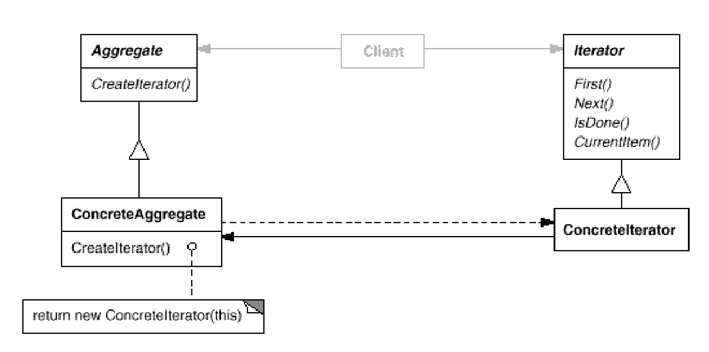目的
不用知道Aggregate Object的內部細節,即可依序存取內含的每一個元素
Provide a way to access the elements of an aggregate object sequentially without exposing its underlying representation.
適用
- 即使對Aggregate Object內部結構一無所知,仍可存取物件內容。
- 以多種方式巡訪Aggregate Object。
- 以一致介面巡訪各種不同的Aggregate Object時(多型巡訪)。
結構及成員
Collaborations: ConcreteIterator記載已巡訪到聚合體的哪一個元素,並可依序巡訪下一個。

影響結果
好處
壞處
實作
誰來控制巡訪過程?
- 如果是由Client控制,這就是外部Iterator;由Iterator自己主導,就是內部Iterator。
- 外部Iterator比內部Iterator更有彈性。
誰來定義巡訪演算法?
- Aggregate Object也可能會定義,此時Iterator只是拿來記錄巡訪狀態而已。這種Iterator就是Cursor,Client以游標當參數呼叫Aggregate Object的Next(),而Next()會改變游標的操作。
- 如果有Iterator負責巡訪演算法,就很容易用不同方式巡訪同一個Aggregate Object。但巡訪演算法可能需要存取Private Attribute,會破壞封裝。
Iterator有多穩健?
- 在巡訪Aggregate Object的同時還去改變Aggregate Object的內容會很危險。若有增刪元素,就可能會重複存取,也可能完全略過。
- 可以透過先複製一份Aggregate Object再巡訪來解決,但會耗效能。
- 穩健(Robust)的Iterator不必將Aggregate Object再複製一份,大部分都需要向Aggregate Object索取Iterator物件,一有增刪動作,Aggregate Object會主動調整Iterator的內部狀態,或者乾脆自己維謢必要資訊以確保巡訪時的正常運作。
其他額外的Iterator操作
最小的操作會包含First()、Next()、IsDone()、CurrentItem()等,但也可能有Previous()、SkipTo()等。
Example:
GlyphStorage
// Abstract Aggregate (類似Java 的 abstract class List)
// 自己設計的Storage資料結構
public interface GlyphStorage {
void add(int index, Glyph element);
void add(Glyph element);
void remove(int index);
void remove(Glyph glyph);
int size();
Glyph get(int index);
Iterator<Glyph> iterator();
}// Concrete Aggregate (類似Java 的 LinkedList或ArrayList)
// 在此資料型態用array,但也可以是其他種
// 內部的method()是為了array而設計,可以不深入研究
public class ArrayGlyphStorage implements GlyphStorage{
private Glyph[] glyphs = new Glyph[10];
private int index = 0;
@Override
public void add(int index, Glyph element) {
int i = index++;
expandArray(glyphs.length+1);
for(int pos = i+1; i < glyphs.length-1; i++){
glyphs[pos+1] = glyphs[pos];
}
glyphs[i] = element;
}
@Override
public void add(Glyph element) {
int i = index++;
expandArray(glyphs.length+1);
glyphs[i] = element;
}
@Override
public void remove(int index) {
if(index < 0)
throw new ArrayIndexOutOfBoundsException();
for(int pos = index; pos < glyphs.length-1; pos++){
glyphs[pos] = glyphs[pos+1];
}
glyphs[glyphs.length-1] = null;
}
@Override
public void remove(Glyph glyph) {
int pos = 0;
while(pos<glyphs.length || !glyphs[pos].equals(glyph)){
pos++;
}
this.remove(pos);
}
@Override
public int size() {
return glyphs.length;
}
@Override
public Glyph get(int index) {
if(index >= glyphs.length)
throw new ArrayIndexOutOfBoundsException();
return glyphs[index];
}
@Override
public Iterator<Glyph> iterator() {
return new ArrayGlyphIterator(this);
}
private void expandArray(int size) {
if(size >= glyphs.length) {
Glyph[] newGlyphs = new Glyph[size];
System.arraycopy(glyphs, 0, newGlyphs, 0, glyphs.length);
glyphs = newGlyphs;
}
}
}// Concrete Aggregate (類似Java 的 LinkedList或ArrayList)
// 在此資料型態用arrayList,但也可以是其他種
// 內部的method()是為了arrayList而設計,直接拿內建arrayList來用
public class ListGlyphStorage implements GlyphStorage{
private ArrayList<Glyph> glyphs = new ArrayList<>();
private int index = 0;
@Override
public void add(int index, Glyph element) {
glyphs.add(index, element);
}
@Override
public void add(Glyph element) {
glyphs.add(element);
}
@Override
public void remove(int index) {
glyphs.remove(index);
}
@Override
public void remove(Glyph glyph) {
glyphs.remove(glyph);
}
@Override
public int size() {
return glyphs.size();
}
@Override
public Glyph get(int index) {
return glyphs.get(index);
}
@Override
public Iterator<Glyph> iterator() {
return new ListGlyphIterator(this);
}
}// Concrete Iterator 繼承 Java內建的 Iterator<T>
// 專屬於 ArrayGlyphStorage的Iterator
// 像 ArrayList和ArrayListIterator的關係
public class ArrayGlyphIterator implements Iterator<Glyph> {
int position = 0;
ArrayGlyphStorage arrayGlyphStorage;
public ArrayGlyphIterator(ArrayGlyphStorage arrayGlyphStorage){
this.arrayGlyphStorage = arrayGlyphStorage;
}
@Override
public boolean hasNext() {
if(position >= arrayGlyphStorage.size() || arrayGlyphStorage.get(position) == null)
return false;
return true;
}
@Override
public Glyph next() {
return arrayGlyphStorage.get(position++);
}
@Override
public void remove() {
arrayGlyphStorage.remove(position-1);
position -= 1;
}
}// Concrete Iterator 繼承 Java內建的 Iterator<T>
// 專屬於 ListGlyphStorage的Iterator
// 像 LinkedList和LinkedListIterator的關係
public class ListGlyphIterator implements Iterator<Glyph> {
int position = 0;
ListGlyphStorage listGlyphStorage;
public ListGlyphIterator(ListGlyphStorage listGlyphStorage){
this.listGlyphStorage = listGlyphStorage;
}
@Override
public boolean hasNext() {
if(position >= listGlyphStorage.size() || listGlyphStorage.get(position) == null)
return false;
return true;
}
@Override
public Glyph next() {
return listGlyphStorage.get(position++);
}
@Override
public void remove() {
listGlyphStorage.remove(position-1);
position -= 1;
}
}// 用例
public class MyGlyphIteratorPattern {
public static void main(String[] args) {
GlyphStorage storage = new ArrayGlyphStorage();
storage.add(new Row());
storage.add(new Text());
storage.add(new Image());
Iterator iterator = storage.iterator(); //仿JAVA內建Iterator的用法
while(iterator.hasNext()){
System.out.println(iterator.next().detail());
}
}
}Result:
This is row glyph
This is text glyph
This is image glyphShape
//Class: Shape
package iterator.shape;
public class Shape {
private int id;
private String name;
public Shape(int id, String name){
this.id = id;
this.name = name;
}
public int getId() {
return id;
}
public void setId(int id) {
this.id = id;
}
public String getName() {
return name;
}
public void setName(String name) {
this.name = name;
}
@Override
public String toString(){
return "ID: "+id+" Shape: "+name;
}
}//Class: ShapeStorage
package iterator.shape;
public class ShapeStorage {
private Shape[] shapes = new Shape[5];
private int index;
public void addShape(String name){
int i = index++;
shapes[i] = new Shape(i,name);
}
public Shape[] getShapes(){
return shapes;
}
}//Class: ShapeIterator
package iterator.shape;
import java.util.Iterator;
public class ShapeIterator implements Iterator<Shape>{
private Shape [] shapes;
int pos;
public ShapeIterator(Shape[] shapes){
this.shapes = shapes;
}
@Override
public boolean hasNext() {
if(pos >= shapes.length || shapes[pos] == null)
return false;
return true;
}
@Override
public Shape next() {
return shapes[pos++];
}
@Override
public void remove() {
if(pos <=0 )
throw new IllegalStateException("Illegal position");
if(shapes[pos-1] !=null){
for (int i= pos-1; i<(shapes.length-1);i++){
shapes[i] = shapes[i+1];
}
shapes[shapes.length-1] = null;
}
}
}//Class: TestIteratorPattern
package iterator.shape;
public class TestIteratorPattern {
public static void main(String[] args) {
ShapeStorage storage = new ShapeStorage();
storage.addShape("Polygon");
storage.addShape("Hexagon");
storage.addShape("Circle");
storage.addShape("Rectangle");
storage.addShape("Square");
ShapeIterator iterator = new ShapeIterator(storage.getShapes());
while(iterator.hasNext()){
System.out.println(iterator.next());
}
System.out.println("Apply removing while iterating...");
iterator = new ShapeIterator(storage.getShapes());
while(iterator.hasNext()){
System.out.println(iterator.next());
iterator.remove();
}
}
}Result:
ID: 0 Shape: Polygon
ID: 1 Shape: Hexagon
ID: 2 Shape: Circle
ID: 3 Shape: Rectangle
ID: 4 Shape: Square
Apply removing while iterating...
ID: 0 Shape: Polygon
ID: 2 Shape: Circle
ID: 4 Shape: Square
